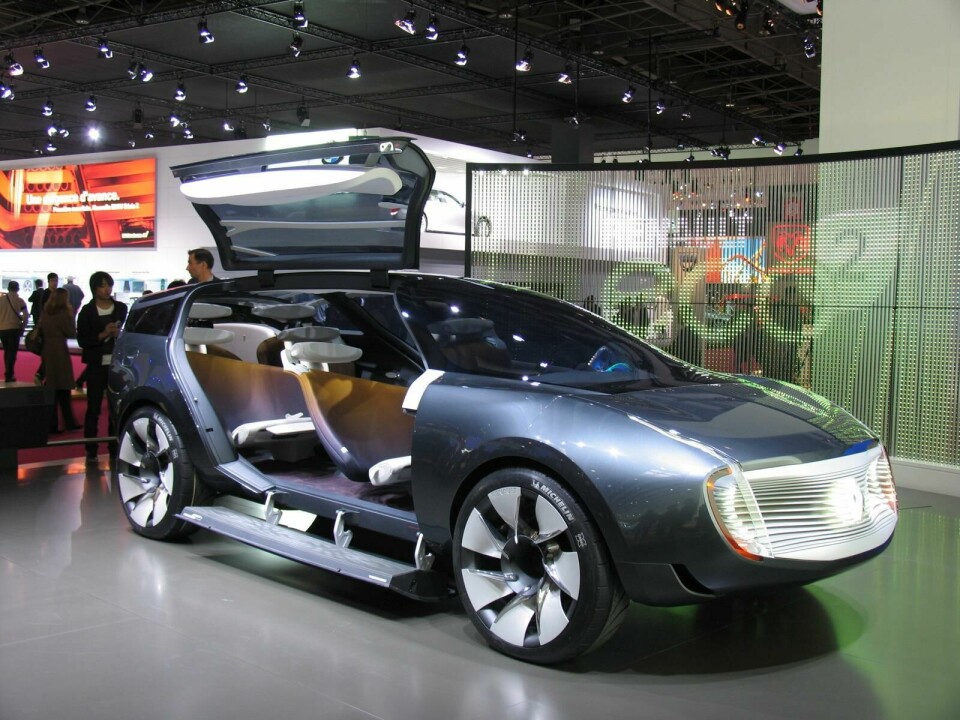
Concept Car of the Week: Renault Ondelios (2008)
A forgotten and misunderstood crossover that has clearly had a wider influence
We had a flashback when we saw the Mercedes IAA concept at the Frankfurt show this week. While many drew parallels to muscle car concepts of the 1970s, for us the very soft surface transitions, low-drag ethos and its flowing front and rear graphic inserts were dead-ringers for the 2008 Renault Ondelios.

The two cars are, of course, very different, but it reminded us that the Renault – one of Patrick le Quément’s last in a series of seminal show cars – was worth revisiting.
Here’s what CDN’s Sam Livingstone wrote of it at the time:

On the Renault stand, the Ondelios followed in the illustrious footsteps of previous large Renault concepts such as the 1995 Initiale, 1998 Vel Satis, 2001 Talisman, 2005 Egeus and 2006 Nepta. At 4.8m long, 2.0m wide and 1.6m tall, the overall dimensions of the Ondelios are very similar to the production Vel Satis, but the concept is pitched as a ‘crossover’ and has the ground clearance and 23-inch wheels to suit.

Historically, Renault concepts have also been previews of the design aesthetic expected on next-generation production designs, but it looks like a bigger challenge to translate the form language of the Ondelios into production than with previous concepts. This is because its design is such a significant departure from current Renault design and because much of this is dependant on new and more expensive materials and production processes.

The new exterior surface treatment is defined by a dark blue anthracite metallic carbon-fibre body and smokey grey polycarbonate glazing that seamlessly flow as one surface around the car, with windows and body panels merging into each other, and minimal extraneous details or shut lines distracting from the mono-surface. Essentially, Renault has removed much of the interplay of graphics and detail design of a conventional exterior, forcing people to view the Ondelios for its proportions and surface quality only – a new and unique way to ‘read’ a car design.

The ends of the car appear to have been sliced off to expose layers beneath the mono-surface exterior. At the front there is a large backlit Renault logo pushed forward by delicate horizontal grille slats that sweep back into the car at the sides where the vertical head lamps are recessed within the front fenders. The huge turbine wheels claim to draw airflow from the side of the car to prevent turbulence, and the two gull-wing doors have a high set lower shut line that emphasises the car’s ‘crossover’ quality. The rockers directly beneath drop down as the doors lift upwards to facilitate ingress and egress.

At the rear, the inner layer of the car protrudes a long way aft – a novel solution that we thought worked very well, although several other observers didn’t. Vertically orientated rear lights are set in the gap between the inner and outer layer and are ‘ringed with air extractors to control the flow of air from the wheel arches’ according to Renault. This gap between the outer and inner layer of exterior continues above the rear end, enabling the tailgate to slide up into this space when it opens, while the lower half opens like a door.

Inside the Ondelios has three rows of seats, each row comprising of two seats designed, like giant leaves, to hug their occupants who can curl up in them to enjoy the comfort and support they afford,’ according to Renault. Like the exterior – and the interiors of previous up-scale Renault concepts such as the Vel Satis, Talisman and Nepta – the interior is quite calm. But unlike its predecessors, the interior of the Ondelios has a fluid, unstructured form language without delineating bone lines.

The lower half of the IP appears to be a continuation of the horizontal slats at the front of the car, also lit from behind. The simple upper IP forms a back-lit interface for communications and other interface menus, while images from the exterior cameras are ahead of this, at the base of the windshield. Behind the steering wheel is one large circular instrument binnacle and, within recesses of the wraparound IP to the side, are paddle-like controls in place of traditional column stalks. Contour-like layers with ambient lighting feature in the headliner. All of this combines to make the interior a genuinely ethereal and very calming environment; the antithesis to the traditional ‘club’ luxury or sporty identity of production premium car interiors.

The primary purpose of the Ondelios is to underscore Renault’s intent to produce a large crossover vehicle to replace the unsuccessful Vel Satis. But as a design the Ondelios is more significant for its ‘mono-surface’ aesthetic that sees convex merge to concave, which merges to convex again; afforded in the main body by the use of polycarbonate glazing. This results in a non-delineated exterior form that must be viewed as a three-dimensional volume in the absence of any graphics; the antithesis of Renault concept such as the Koleos of 2003. The design is also significant in that it progresses a new type of ‘chill-out’ modern, premium interior aesthetic that builds on earlier Renault ideas with a new, organic form language.

Unfortunately the Ondelios failed to win the approval of its audience in Paris as previous Renault concepts have. The many subtle innovations of the interior were missed except by the few that gained access; and while many car designers enjoyed the new form language and innovative front and rear treatments, many were also uncomfortable that this in turn resulted in an amorphous and rather bulky exterior.

The majority of the mainstream press – and presumably public observers – also latched on to the slightly ungainly proportions that its consistent surface treatment was bound not to affect. As such the Ondelios is sold short: this is a truly exciting and experimental car blighted by its failure to instantly charm show goers.




